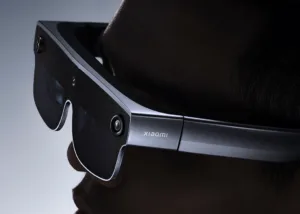At Mobile World Congress 2023 (MWC 2023), the company unveiled its AR offering with a retina-level adaptive display that adjusts to the lighting environment, and enhanced connectivity to its Snapdragon Spaces ready smartphone. The Xiaomi Wireless AR Glass Discovery Edition is just 126g and is built on the Snapdragon XR2 Gen 1 Platform and features a Xiaomi proprietary low-latency communication link with latency as low as 3ms between the smartphone device and glasses, and a wireless connection with full link latency as low as 50ms, comparable to a tethered solutions. The AR glasses use a range of lightweight materials such as magnesium-lithium alloy, carbon fiber parts, and a self-developed silicon-oxygen anode battery.
The AR Glasses OLED Displays
Xiaomi claims its Wireless AR Glasses are amongst the industry’s first to achieve a “retina-level” display. When angular resolution or PPD (pixels per degree) approaches 60, the human eye cannot distinguish granularity. The PPD of the Xiaomi Wireless AR Glasses is 58, which is the industry-leading closest to meeting this quality specification.
Leveraging a free-form optical module that comprises a pair of microOLED screens (built by Sony, perhaps), Xiaomi Wireless AR Glass also comes with free-form light-guiding prisms to achieve a clear picture display. These free-form prisms are capable of performing complex light refraction in a limited volume. The content displayed on the screen is reflected by three surfaces within the light-guiding prisms, resulting in a final presentation in front of the user’s eyes.
The AR glasses’ optical module design minimizes light loss and produces clear and bright images with a to-eye brightness of up to 1200nit, providing a strong foundation for AR applications. Additionally, the AR glasses come equipped with electrochromic lenses that can adapt to different lighting conditions. These lenses enable a blackout mode that offers an immersive experience when viewing content, while the transparent mode produces a more vivid AR experience that blends reality and virtual elements.
Xiaomi AR Gesture Control, a more natural way to interact
Xiaomi Wireless AR Glass also features an innovative self-researched micro gesture interaction that enables one-handed, highly-precise pure gesture interaction. This kind of interaction showcases one of the directions that Xiaomi believes human-computer interaction will take in the future.
Xiaomi utilizes the joints of the user’s inner fingers as a gesture recognition area for Xiaomi Wireless AR Glasses. The directional is oriented from the second joint of the middle finger, with the second joint of the index finger representing the upward direction. When combined with the surrounding areas, this forms a four-way directional key for basic movement operations. In addition, the 12 knuckles function similarly to the Chinese nine-key input method, allowing for text input through thumb tapping in the finger area. The thumb sliding on the index finger is used to enter and exit applications. Looking forward, Xiaomi hopes to enable sliding and tapping operations through the random movement of the thumb in the palm.
Micro gestures on Xiaomi Wireless AR Glass enable users to perform daily app usage operations such as selecting and opening apps, swiping through pages, and exiting apps to return to the start page, all without using a smartphone for controls.
Xiaomi Wireless AR Glass incorporates a low power-usage AON camera that enables prolonged gesture interaction and facilitates features. Furthermore, users can also opt for conventional smartphone controls, which can be paired and used as a gesture or touchpad control.
Xiaomi Wireless AR Glasses Discovery Edition requires pairing with Xiaomi 13 or other Snapdragon Spaces ready device. The glasses are available in a titanium-colored design and support three sizes of nosepieces. Nearsighted users can use an attachable myopic clip. In terms of software support, the glasses are compatible with Qualcomm Snapdragon Spaces, OpenXR, and Microsoft MRTK development framework. Xiaomi intends to work closely with developers to expedite the arrival of AR.

